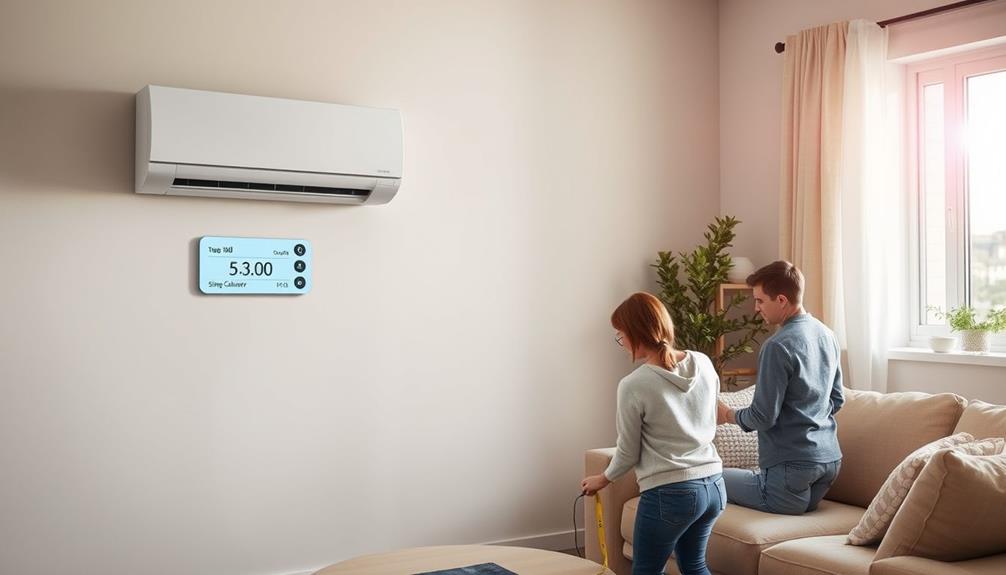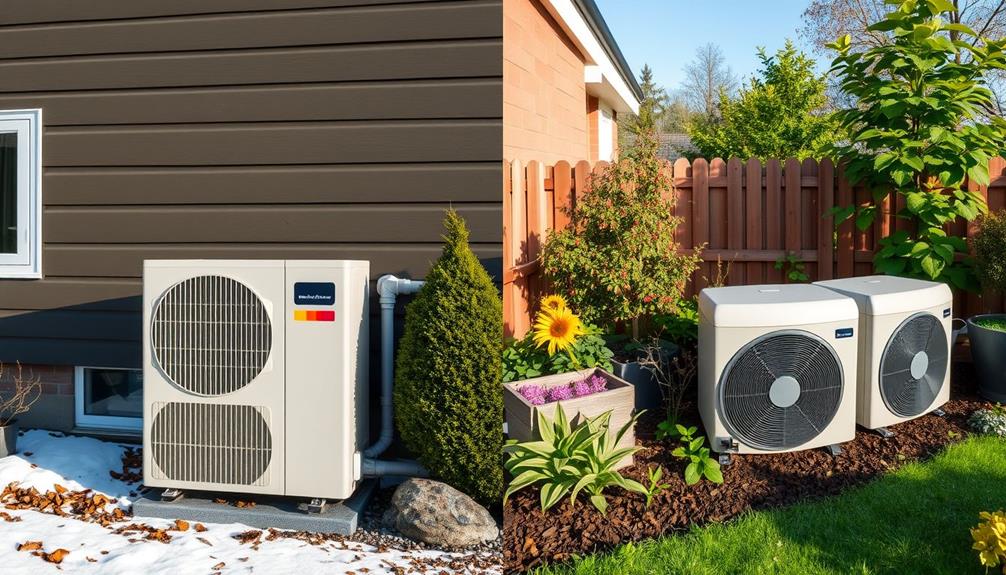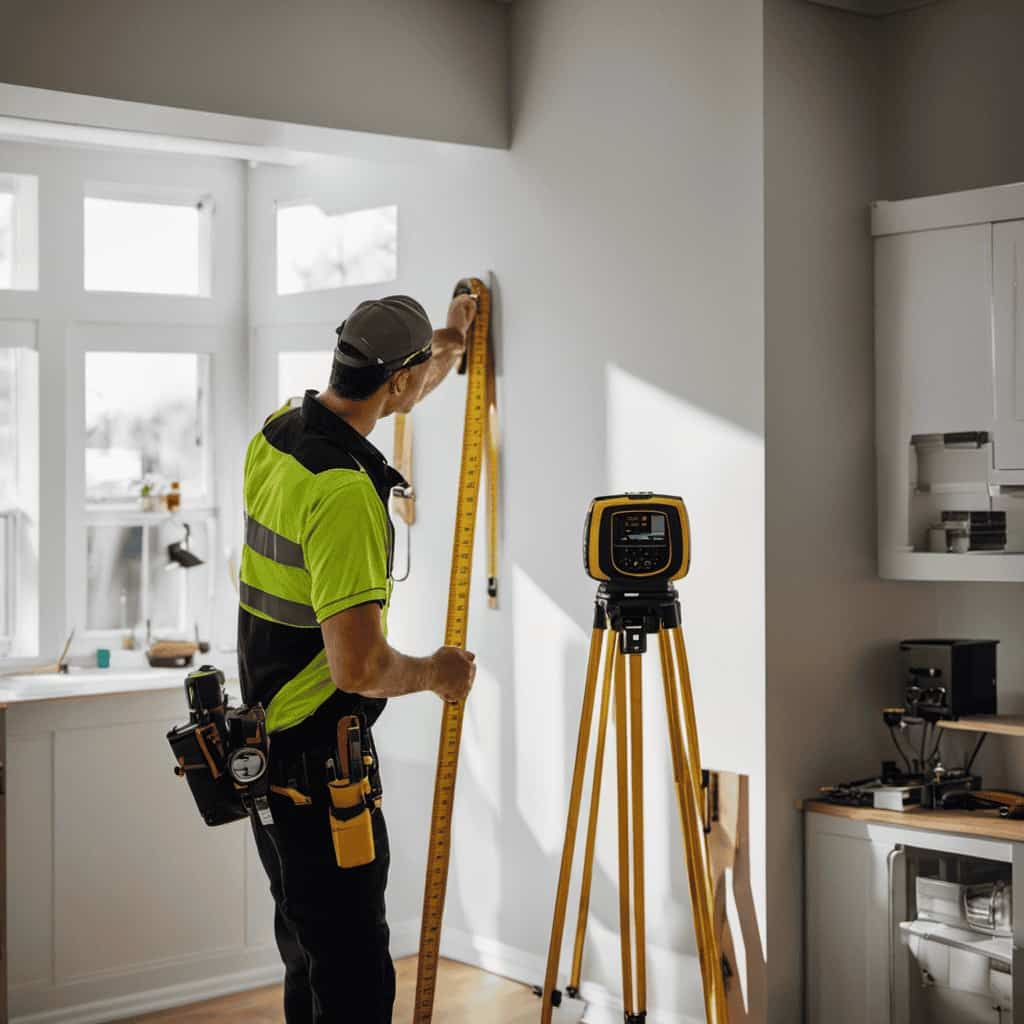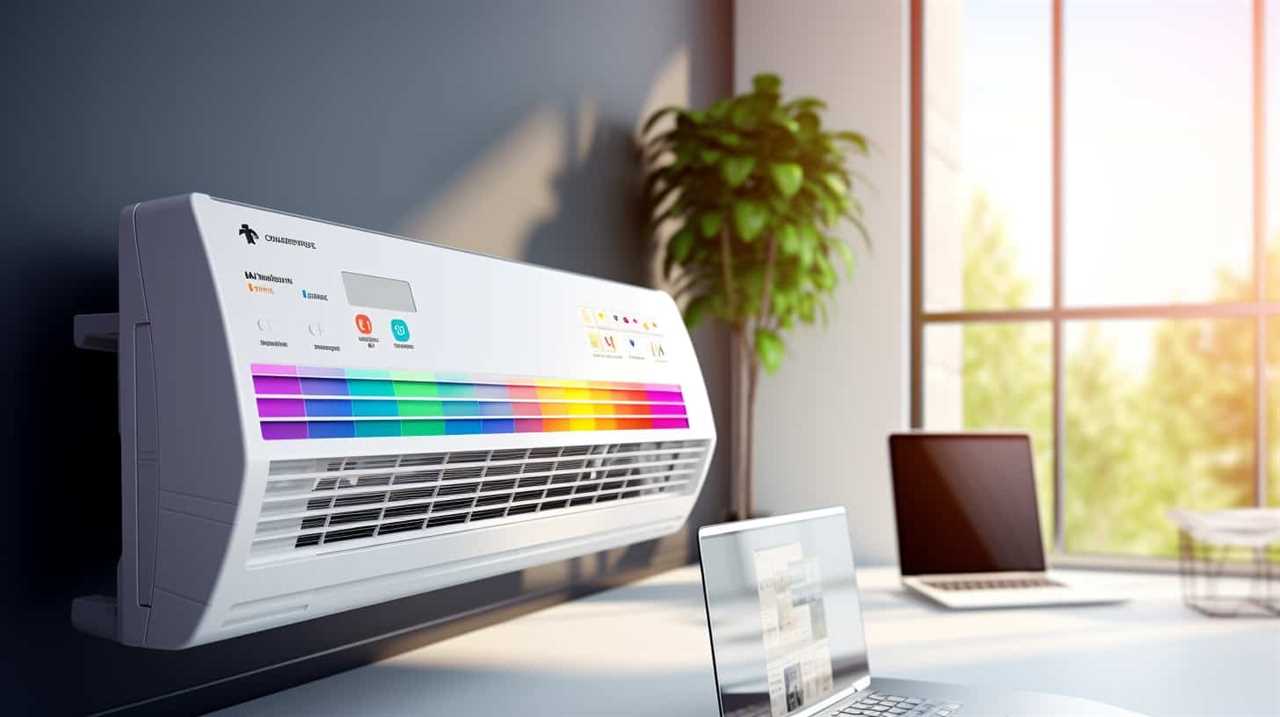To determine the right size for your heat pump, start by evaluating your home's insulation, layout, and local climate. Use the Manual J Load Calculation method for the most accurate results. This professional approach considers key factors like square footage and air leakage, preventing common mistakes that often lead to oversized units. Oversizing can cause energy waste and discomfort, while undersizing can leave you cold during extreme weather. Consulting an HVAC expert will guarantee your heat pump meets your unique needs effectively. There's plenty more to explore about achieving ideal comfort and efficiency for your home.
Key Takeaways
- Accurate heat pump sizing requires a Manual J Load Calculation to consider unique home features and local climate conditions.
- Oversized or undersized units can lead to discomfort, increased energy costs, and inefficiency in heating and cooling.
- Common sizing methods often miscalculate requirements by thousands of BTUs, leading to significant errors.
- Engaging HVAC professionals can provide tailored assessments, ensuring long-term energy savings and optimal performance.
- Key factors include square footage, insulation quality, and window efficiency, all of which influence heating and cooling needs.
Importance of Proper Sizing
When it comes to heating and cooling your home, proper sizing of your heat pump is crucial. If you don't get the heat pump sizing right, you could face discomfort and higher energy bills.
An oversized heat pump may short cycle, causing performance issues and reducing its lifespan. On the flip side, an undersized unit might struggle to keep your home comfortable, particularly during extreme weather conditions.
To enhance overall home comfort, consider integrating home comfort solutions that complement your heating system. Many homeowners mistakenly rely solely on square footage for sizing, which can lead to significant discrepancies in BTU requirements.
In fact, data shows that oversizing can average around 31,000 BTUs in some cases. To avoid such pitfalls, accurate sizing must consider factors beyond just square footage, like home insulation, layout, local climate, and window efficiency.
Engaging professionals for a Manual J Load Calculation guarantees you get the right sizing tailored to your specific needs. This approach not only enhances system performance but also leads to long-term savings.
Ultimately, investing in proper sizing will help you achieve ideal heating and cooling load management, guaranteeing your home stays comfortable year-round.
Consequences of Improper Sizing
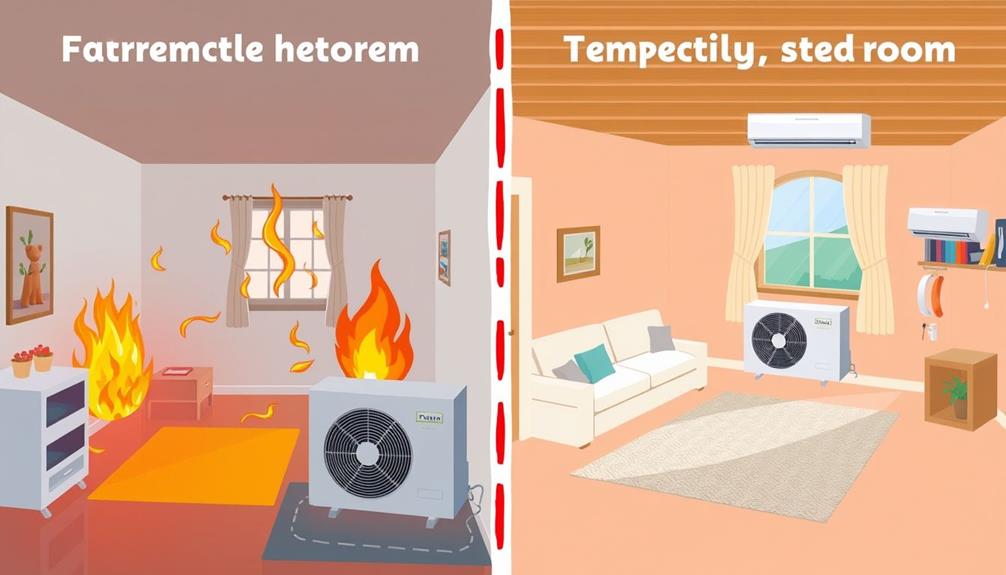
Improperly sizing your heat pump can lead to serious issues.
If you choose an undersized unit, you'll find it struggling to keep your home comfortable during extreme temperatures, while an oversized unit will constantly cycle on and off, resulting in higher repair costs.
Both scenarios can lead to wasted energy, increased bills, and a shorter lifespan for your system.
In addition, common causes of heat pump failures can be exacerbated by improper sizing, leading to refrigerant leaks and electrical issues that may arise from the system's inefficiencies.
Undersized Unit Challenges
Many homeowners underestimate the challenges posed by undersized heat pumps, which can leave you facing uncomfortable living conditions. An undersized unit struggles to maintain your desired temperature, especially during extreme cold spells. This often forces you to rely on backup electric resistance heating, considerably raising your energy costs.
Additionally, as with choosing a home cleaning service, understanding the specific needs of your home is essential for guaranteeing peak performance.
You might notice hot and cold spots throughout your home, leading to discomfort when your heating isn't consistent. As your undersized unit works harder to meet heating loads, it can overheat and lead to premature system failures. This not only disrupts your comfort levels but can also increase the need for costly repairs or even replacements.
Inadequate heating from an undersized unit may drop your indoor temperature below acceptable comfort levels, making winter months particularly unbearable. Ultimately, these challenges can affect your home's livability and drive up your overall energy costs.
To avoid these issues, it's vital to make certain your heat pump is properly sized for your home's specific needs. Investing in the right size can help you maintain a comfortable environment while keeping energy expenses in check.
Oversized Unit Issues
Oversizing a heat pump can lead to significant discomfort and inefficiency in your home. An oversized heat pump typically results in frequent cycling, where the system turns on and off rapidly. This not only reduces energy efficiency but also causes uneven temperature distribution, leaving some rooms too hot or too cold.
You might notice that your utility bills skyrocket due to wasted energy, as your unit works harder than necessary. Additionally, understanding metrics that track visitor engagement can provide insights on how to optimize your heating system for better performance.
In humid climates, an oversized unit struggles to effectively dehumidify the air. This can lead to mold growth and compromised indoor air quality, posing health risks for you and your family. According to the Massachusetts Clean Energy Center, many homes experience significant oversizing, averaging an excess of 31,000 BTUs, which contributes to these issues.
Moreover, during extreme temperatures, an oversized heat pump may fail to meet the required heating capacity when it's most needed, leaving you uncomfortable. Increased wear and tear on the unit can also shorten its lifespan, leading to higher repair and replacement costs.
To guarantee comfort and efficiency, it's essential to properly size your heat pump.
Inaccuracy of Sizing Methods
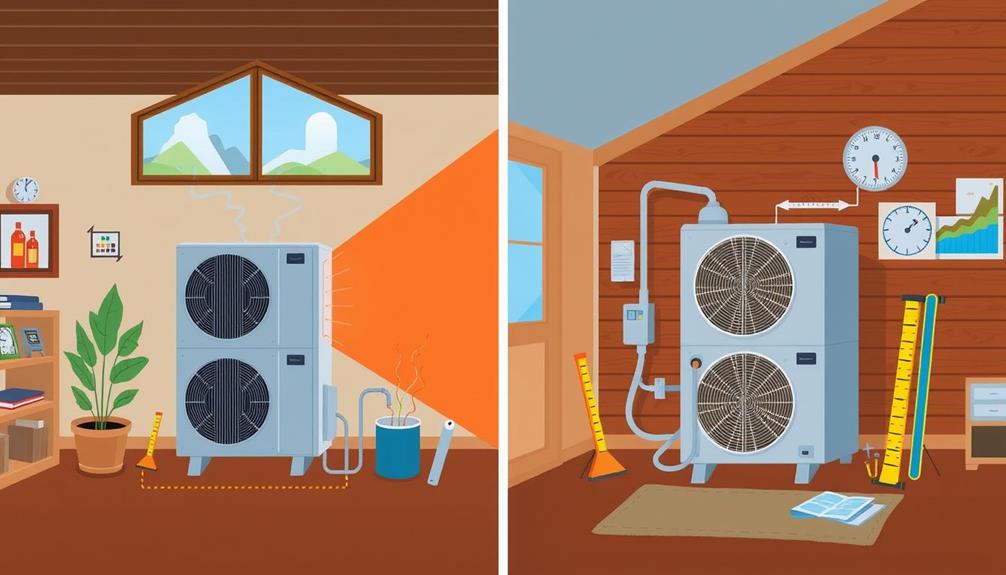
When you're sizing a heat pump, relying on common rules of thumb can steer you wrong, often leading to estimates that miss the mark by thousands of BTUs.
For example, improper sizing can lead to excessive water usage, similar to the challenges faced with toilet water mechanics and septic systems.
Online calculators might seem convenient, but they often overlook essential factors specific to your home, which can lead to inefficient systems.
To avoid these pitfalls, consider consulting an experienced contractor for more accurate sizing methods.
Common Misconceptions in Sizing
Sizing a heat pump isn't as straightforward as it might seem, and relying on common misconceptions can lead to significant issues. Many homeowners turn to common rules of thumb, like using 30 BTUs per square foot, which often results in oversizing.
In fact, homes in Massachusetts have averaged an oversizing of 31,000 BTUs. The contractor method of dividing square footage by 500 isn't much better; it can miscalculate heat pump size for 30% of homes, making them either oversized or undersized.
Additionally, it's crucial to evaluate the unique features of your home and surrounding environment, similar to how one would assess local regulations and permits required for other home improvements.
Another key factor is load calculation, which must take into account specific variables like insulation and air leakage. Online calculators frequently overlook these details, leading to flawed estimates.
Misunderstanding your home's unique characteristics—like its layout and occupancy—can also skew sizing, affecting both efficiency and comfort.
Limitations of Online Calculators
Many homeowners mistakenly trust online calculators for heat pump sizing, believing they provide accurate estimates. However, these tools have significant limitations that can lead to oversizing. According to the Massachusetts Clean Energy Center, online calculators often oversize systems by an average of 31,000 BTUs, which is excessive for many homes. A holistic lifestyle approach, such as stress management techniques, can enhance overall well-being and may help in evaluating your home's specific energy needs.
These calculators typically rely on simplified assumptions and general rules of thumb, neglecting vital variables such as insulation quality, air leakage, and local climate conditions. This results in load calculations that don't reflect your actual heating and cooling needs.
Additionally, they often overlook architectural features and occupancy patterns, which can further skew estimates. Automatic data filling in these calculators can introduce errors if you don't carefully review your input details. This oversight might escalate installation costs by thousands of dollars.
To guarantee accurate sizing, it's important to take into account a detailed evaluation like a Manual J Load Calculation. This thorough approach accounts for a variety of factors, leading to a more precise fit for your home's specific requirements.
Relying solely on online calculators can result in costly mistakes you could easily avoid with professional help.
Accurate Heat Pump Sizing Methods
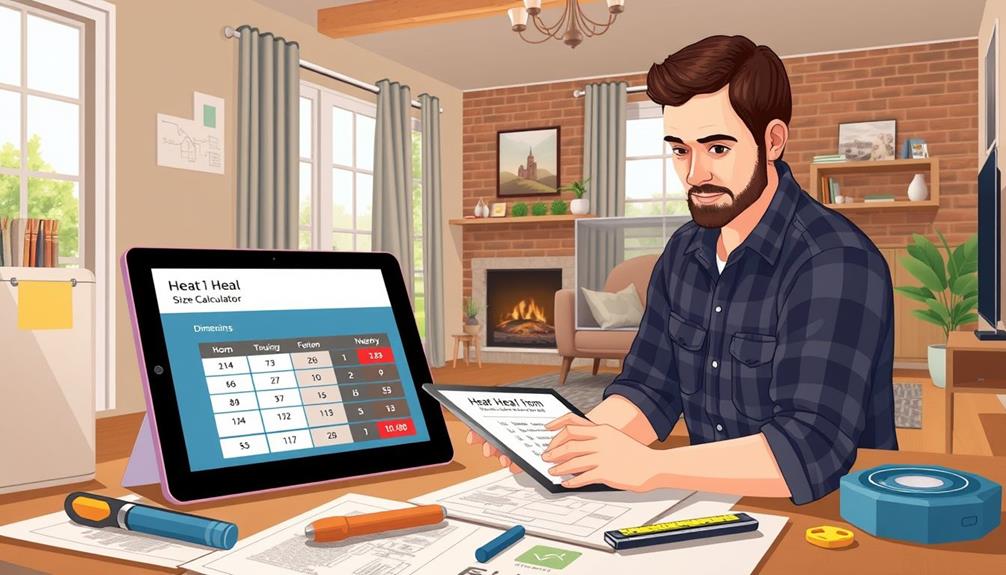
Accurate heat pump sizing is vital for ideal efficiency and comfort in your home. The Manual J Load Calculation is the industry standard method to achieve this. It considers factors like home layout, insulation quality, and local climate conditions, providing a detailed assessment of your heating and cooling needs.
Relying solely on online calculators may lead to oversizing or undersizing, which can greatly affect your home energy costs. Proactive measures for maintaining home and network security are also important, as they guarantee a safe environment for your HVAC system to operate efficiently cybersecurity challenges.
To get it right, you should engage experienced HVAC professionals who can perform a thorough evaluation. They often conduct blower door tests to measure air leakage and assess the overall insulation effectiveness. These tests help pinpoint specific issues that can impact heat pump sizing.
Additionally, understanding your square footage is vital, but it's just one piece of the puzzle.
Factors Influencing Sizing
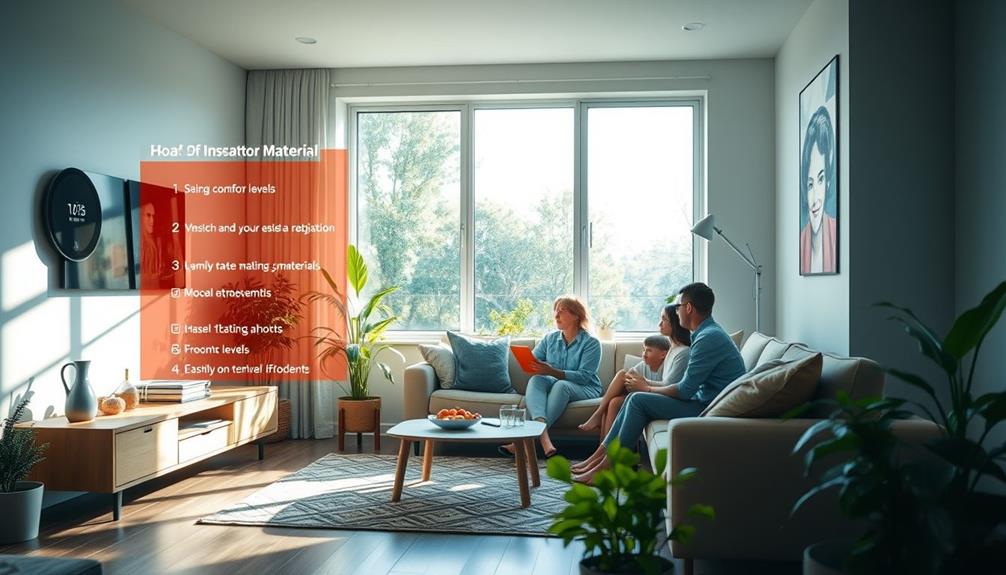
Several key factors play an essential role in determining the appropriate size for your heat pump.
First, the square footage of your home is vital; generally, you'll need about 1 ton of cooling capacity for every 500 square feet.
Next, consider your home's insulation quality. If your space is tightly insulated, it'll require less heating and cooling power compared to older, drafty buildings.
Additionally, guaranteeing good indoor air quality can complement your heat pump's efficiency, especially if you utilize ozone air purifiers to manage allergens and odors.
Local climate is another significant factor. In colder areas, you'll need a heat pump with higher heating capacity, while hotter climates will require more cooling.
Don't forget about your windows—they can greatly affect heat loss or gain. The number and efficiency ratings of your windows should be factored into your calculations.
Lastly, think about how you use your space. The number of occupants and their activities can influence the required capacity for effective temperature control.
Expert Consultation Benefits
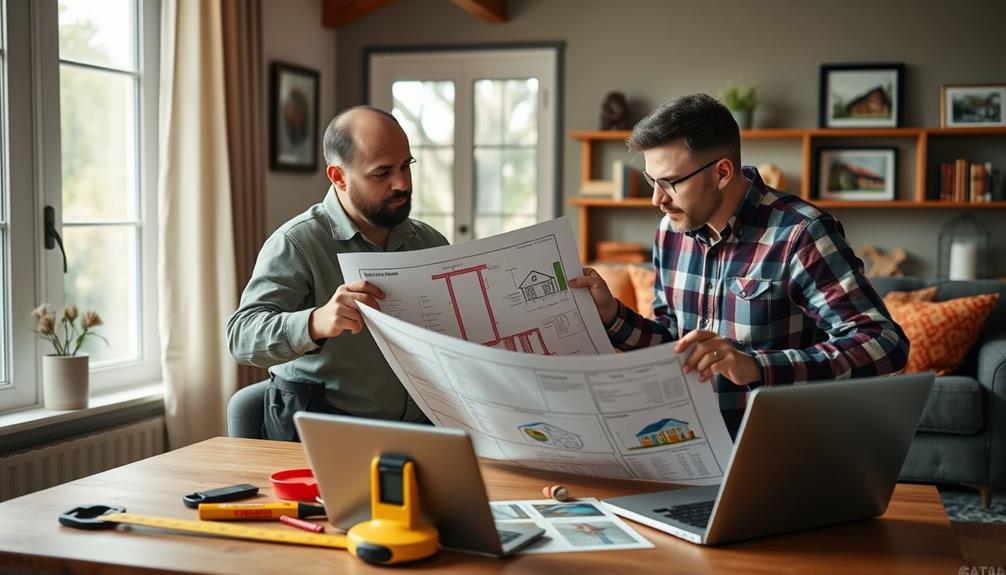
When it comes to selecting the right heat pump, consulting with HVAC professionals can make a significant difference. Their expert consultation guarantees accurate load calculations, which are essential for tailoring a heat pump to your specific home characteristics.
Experienced contractors use industry-standard methodologies and tools, like Manual J Load Calculation and blower door tests, to analyze factors such as insulation quality and air leakage. Additionally, involving the whole family in the decision-making process can cultivate digital creativity by exploring online resources and tools that help visualize potential options for your home.
These professional assessments investigate deeper than general sizing rules or online calculators, leading to more precise recommendations. By considering variables like occupant behavior and potential future changes in space usage, professionals provide insights that you might overlook.
Moreover, investing in expert consultation can lead to long-term savings on energy bills and maintenance costs. Properly sized systems enhance energy efficiency, guaranteeing your HVAC system runs smoothly and reliably. This not only improves comfort but also extends the lifespan of your equipment.
In short, having an HVAC professional guide you through the heat pump selection process can yield significant benefits, making your home more comfortable while maximizing efficiency and savings.
Tools for Heat Pump Sizing
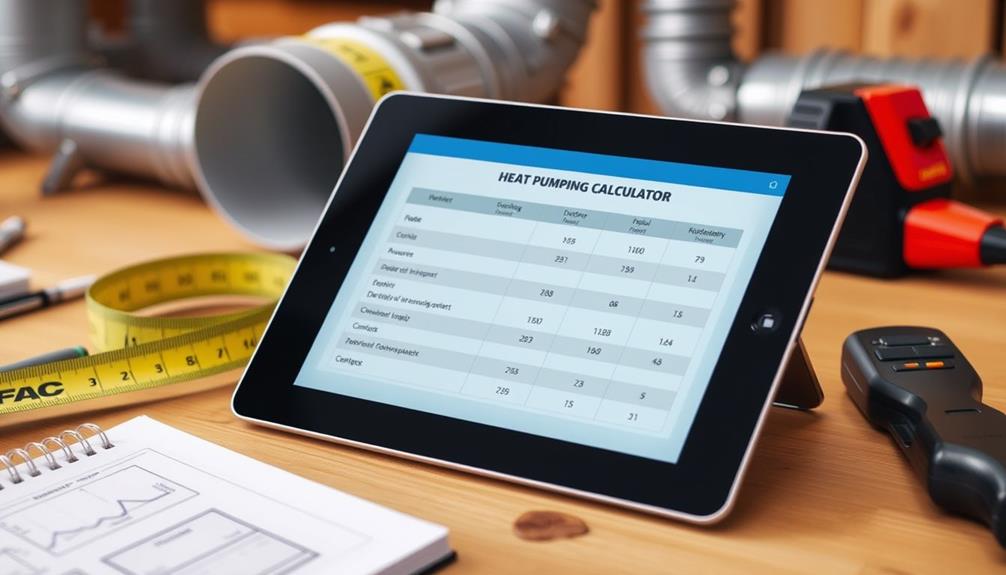
Understanding the tools available for heat pump sizing can greatly enhance your ability to select the right system for your home. One of the most trusted resources is ACCA's Manual J, which provides detailed measurement procedures for determining heating and cooling loads. This method considers key factors like your home's size, layout, insulation quality, and air leaks.
For a more automated approach, you can use CoolCalc, a free software approved by ACCA that streamlines Manual J calculations. It only requires email registration, making it easy to access accurate heat pump load assessments.
Another valuable tool is BEOpt, developed by the U.S. Department of Energy, which allows you to self-size heat pumps based on your home's specific characteristics.
While these tools are excellent for DIY assessments, it's often best to consult with professional installers. They utilize advanced methodologies, like blower door tests and Manual J calculations, to guarantee precise sizing tailored to your individual heating load needs.
Weather Impact on Sizing
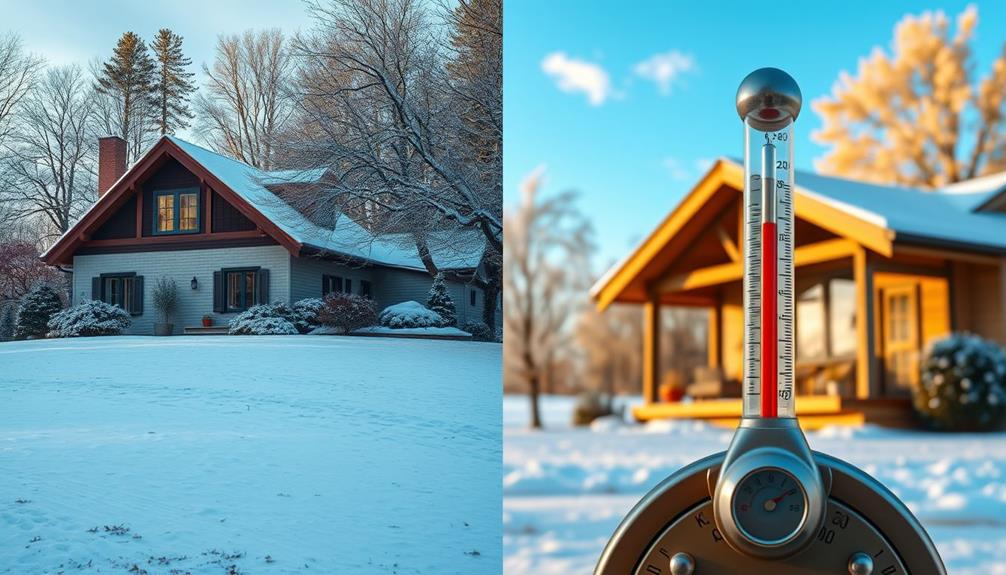
Weather can considerably impact the sizing of your heat pump, as its performance is closely tied to the building's maximum heating and cooling loads, which fluctuate with extreme temperatures.
To determine the heat pump you need, it's essential to assess these loads in relation to seasonal temperature fluctuations. For instance, many standard heat pumps may struggle in freezing conditions, leading to a significant drop in capacity. When temperatures dip, the performance can fall to as low as 2.8 tons at local lows of 17°F, regardless of the advertised size.
In cold climates, cold climate heat pumps are necessary, as they maintain better capacity in low temperatures compared to standard models. This can make a significant difference in your heating or cooling efficiency.
Additionally, it's crucial to verify that your heat pump aligns with the required number of BTUs for both heating and cooling needs. If you live in an area with high humidity, sizing becomes even more important; oversized units may not effectively dehumidify, leading to discomfort.
Always keep these factors in mind to guarantee optimal performance and comfort in your home.
Key Takeaways for Sizing
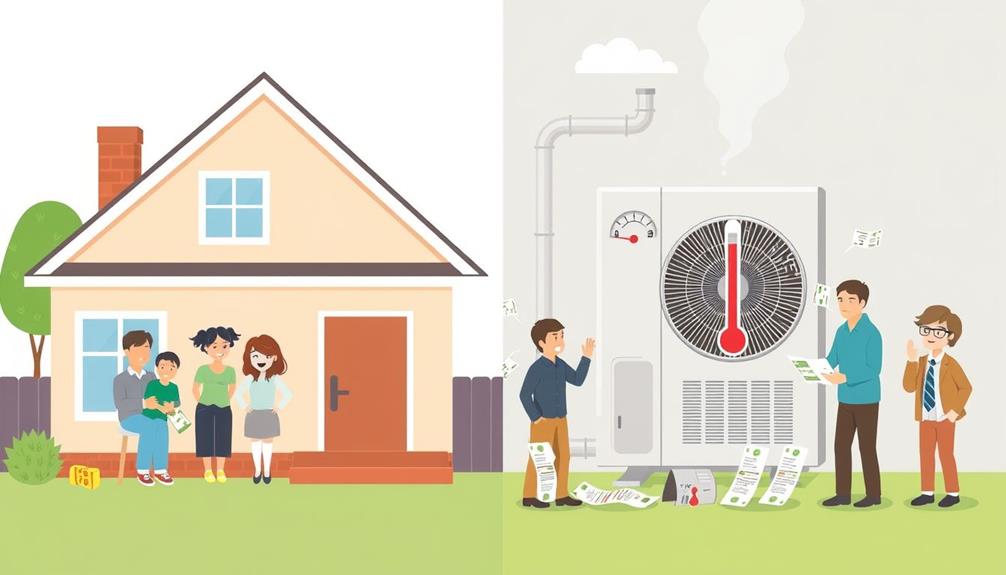
Getting the right heat pump size is vital for maintaining comfort and efficiency in your home. An undersized unit will struggle during extreme weather, while an oversized unit can lead to frequent cycling and uncomfortable temperature fluctuations.
To avoid these issues, use the Manual J Load Calculation, which is the industry standard for accurate sizing. This method considers your home's layout, insulation quality, and local climate conditions to determine the Right Size Heat Pump.
Beware of common sizing mistakes, like relying solely on square footage or general rules of thumb. These can lead to oversizing units by an average of 31,000 BTUs, resulting in wasted energy and higher costs.
Accurate inputs are essential for tools like CoolCalc; even minor inaccuracies can lead to installation cost discrepancies of thousands of dollars.
To guarantee precise assessments, engage experienced HVAC professionals or independent energy auditors. They can provide the expertise needed for accurate sizing, ultimately leading to long-term energy savings and optimized heat pump performance.
With the right size heat pump, you'll enjoy a comfortable home while minimizing energy waste.
Frequently Asked Questions
How Do I Size a Heat Pump for My House?
To size a heat pump for your house, you need to take into account factors like home size, insulation, and local climate. A professional assessment guarantees you get the right fit for ideal performance and energy efficiency.
Is It Better to Oversize or Undersize a Heat Pump?
You might think oversizing a heat pump guarantees comfort, but it actually leads to inefficiency and wear. Undersizing? That's a struggle. Proper sizing strikes the balance for energy efficiency and consistent comfort in your home.
What Size Heat Pump Do I Need for a 2000 Sq Ft Home?
For a 2,000 sq ft home, you'll generally need around a 4-ton heat pump, but factors like insulation, climate, and layout can affect this. Always consider a professional assessment for the best results.
How Many Square Feet Will a 12000 BTU Heat Pump Heat?
Imagine cozying up in a snug 600-square-foot space when winter chills approach. A 12,000 BTU heat pump efficiently warms that area, ensuring you're comfortable even in the coldest days, depending on insulation and climate.
Conclusion
Just like a tailor crafts a suit to fit you perfectly, sizing your heat pump is essential for comfort and efficiency. If it's too small, you'll be left shivering in the cold; too big, and you'll be wasting energy and money. By considering the right factors and consulting experts, you can find the perfect fit for your home. So, take the time to measure and assess, and enjoy a cozy haven tailored just for you.
